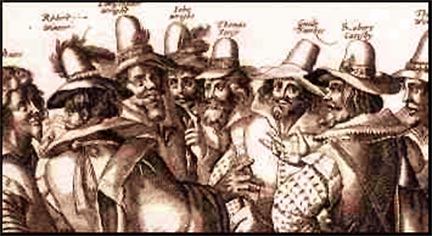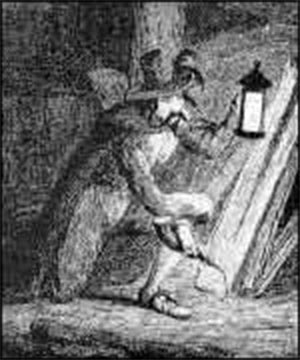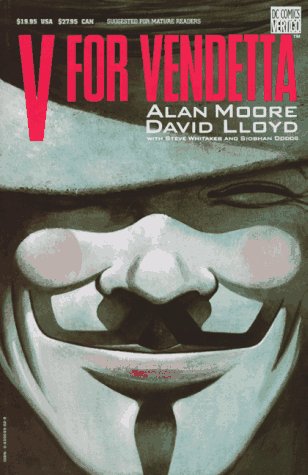Gunpowder Plot
From the Quicksilver Metaweb.
a bit more than a stub for the Guy
Stephensonia
Hinted at in the history lesson Enoch Root gives young Ben Franklin
Authored links
Gunpowder Plot
from the Wikipedia
The Gunpowder Plot of 1605, involved a desperate but failed attempt by a group of provincial English Catholics to kill King James I of England, his family, and most of the Protestant aristocracy in one fell swoop by blowing up the Houses of Parliament during the state opening.

The Conspirators in the Gunpowder Plot
The conspirators had become disillusioned by James's failure to give equal rights to Catholics. The plot was intended to spark a rebellion during which, they hoped, James's daughter Elizabeth would be installed as a Catholic head of state. The plot miscarried on November 5 hours before the plot was to have been enacted.
On 5 November each year, Britons in the UK and abroad celebrate the failure of the plot in Bonfire night (also known as Fireworks night or Guy Fawkes night).
The plot was masterminded by Robert Catesby, and executed by Guido (Guy) Fawkes the explosives expert. The other plotters were Thomas Wintour, Robert Wintour, Christopher Wright, Thomas Percy, John Grant, Ambrose Rokewood, Robert Keyes, Sir Everard Digby, Francis Tresham and Catesby's servant, Thomas Bates.
The plotters were able to rent a cellar in the house adjacent to the old House of Lords (where the State Opening of Parliament would take place) and tunnelled through to the cellar directly below.
By March 1605 they had filled the cellar underneath the House of Lords with 36 barrels (approximately 2.5 tonnes) of gunpowder, concealed under a store of winter fuel. Yet a fear for the Catholic lords who would inevitably be killed led to someone (possibly Francis Tresham) writing a letter of warning to a prominent Catholic, Lord Monteagle, who received it on Saturday, October 26. The conspirators learned of the letter the following day, but resolved to go ahead with their plan, especially after Fawkes inspected the cellar and found nothing had been touched. Meanwhile, however, Monteagle showed the letter to Robert Cecil, the secretary of state.
Due to this tip-off, the cellar was raided on the morning of the 5th of November by Thomas Knyvet, a justice of the peace, who found conspirator Guy Fawkes in a cellar below the Parliament building and ordered a search of the area. The authorities found the barrels of gunpowder and placed Fawkes under arrest. Guy Fawkes was tortured on the rack until he confessed to his involvement in the plot and to the names of the other conspirators; the King signed a specific order allowing for torture, otherwise outlawed in England. All the conspirators were soon caught, and were executed or killed during interrogation.

Guy Fawkes
Creeping Through The Cellars
Many modern historians think that Cecil's agents had infiltrated the plot early on in its gestation but allowed it to continue for dramatic effect; certainly the propaganda value of a 'Popish plot' was not underplayed during the next few hundred years.
On Guy Fawkes night, communities have a fireworks display and a bonfire on which they burn an effigy of Guy Fawkes known as a Guy. At one time the burning of effigies of the Pope was also common but this practice is only continued now in Lewes in East Sussex. In a few places it has become traditional around this time to suggest that it might not have been such a bad thing if the plot had succeeded.
The plot is immortalised in the popular verse:
Remember, remember the fifth of November, the gunpowder treason and plot, I see no reason why gunpowder treason should ever be forgot. Guy Fawkes, Guy Fawkes, 'twas his intent to blow up the King and the Parliament. Three score barrels of powder below, Poor old England to overthrow: By God's providence he was catch'd With a dark lantern and burning match. Holloa boys, holloa boys, make the bells ring. Holloa boys, holloa boys, God save the King! Hip hip hoorah!
(traditionally the following verses were also sung, but they have fallen out of favour because of their content) A penny loaf to feed the Pope. A farthing o' cheese to choke him. A pint of beer to rinse it down. A faggot of sticks to burn him. Burn him in a tub of tar. Burn him like a blazing star. Burn his body from his head. Then we'll say ol' Pope is dead. Hip hip hoorah! Hip hip hoorah!
The plot backfired spectacularly upon England's Catholics. It halted any moves towards Catholic emancipation: they would have to wait another 200 years until they received approximately equal rights.

V FOR VENDETTA
The Protagonist in his Guy Fawkes Mask
Modern physicists have calculated that if the Plot had succeeded, it would have have destroyed buildings throughout much of Westminster, and shattered glass windows within a 2/3 mile (1 kilometer) radius (window glass having only recently become common).
In Fiction
In the dystopian science fiction graphic novel, V for Vendetta by Alan Moore, V, a mysterious anarchist who disguises and models himself as a latter day Guy Fawkes, finally explodes the abandoned parliament buildings on a future November 5 as his first move to bring down a nightmarish Thatcher inspired English nation's Brownshirted tyranny. It's also an element in Diana Wynne Jones' Witch Week.
Related links
- Enoch Root
- Ben Franklin
- Elizabeth I of England
- James II of England
- Elizabeth of Bohemia
- Alchemy
- Charles V
- Richelieu
External links
- Westminster
- dystopian
- science fiction
- graphic novel
- V for Vendetta Amazon Listing of V for Vendatta
- Alan Moore
- anarchist
- Friday, a science fiction novel by Robert E. Henlein, mentioned as an example.
- Thatcher
- Brownshirts
- Diana Wynne Jones